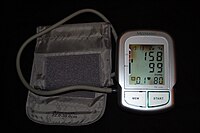
Photo from wikipedia
Objective: To assess the prevalence of white-coat (WCH) and masked (MH) hypertension detected by only ambulatory or only home blood pressure (BP) monitoring (isolated), or both (dual), and their association… Click to show full abstract
Objective: To assess the prevalence of white-coat (WCH) and masked (MH) hypertension detected by only ambulatory or only home blood pressure (BP) monitoring (isolated), or both (dual), and their association with preclinical target organ damage (TOD). Design and method: Young individuals referred for elevated BP and healthy volunteers aged 6–25 years were evaluated with office (2–3 visits; triplicate measurements), home (7 days, duplicate morning and evening measurements) and 24-hour ambulatory BP monitoring. TOD assessment included echocardiographic left ventricular mass index (LVMI), carotid intima-media thickness (IMT) and pulse wave velocity (PWV; Complior). Normotension (NT) was defined as normal office, home and ambulatory BP and sustained hypertension (SH) as all measurements being elevated. WCH and MH phenotypes were identified based on isolated or combined (dual) home and ambulatory BP values. Results: Analysis included 320 individuals (mean age 13.8 ± 3.8 years, 66.6% males, 32.2% children, 55.9% adolescents, 11.9% young adults, BMI 24.1 ± 4.8 kg/m2), of whom 276 had LVMI, 212 IMT and 168 PWV assessment. 182 (56.9%) participants had NT and 39 (12.2%) SH. Among 54 (16.9%) participants with WCH, 35 had dual WCH (64.8%) and 19 (35.2%) isolated ambulatory or home WCH. Among 45 (14.1%) with MH, 17 had dual MH (37.8%) and 28 isolated ambulatory or home MH (62.2%). Participants with dual and isolated intermediate phenotypes didn’t differ according to age, sex and BMI. Individuals with SH had higher LVMI, IMT and PWV than NT (all P < 0.05; Figure). Intermediate phenotypes based on selective or combined elevation of out-of-office BP presented intermediate values of indices of TOD between NT and SH. Isolated ambulatory or home WCH was associated with higher LVMI values than NT (P < 0.05), whereas dual MH was associated with higher IMT than NT (all P < 0.05). Conclusions: These findings suggest that in young individuals intermediate hypertension phenotypes with selective (isolated WCH) or combined elevation of BP (dual MH) in out-of-office measurement methods appear to carry an increased risk of preclinical TOD compared with NT.
Journal Title: Journal of Hypertension
Year Published: 2022
Link to full text (if available)
Share on Social Media: Sign Up to like & get
recommendations!